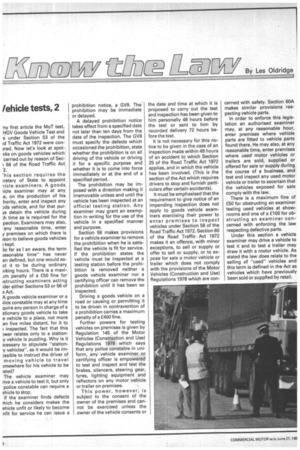fehicle tests, 2
Page 54

If you've noticed an error in this article please click here to report it so we can fix it.
ny first article the MoT test, HGV Goods Vehicle Test and s under Section 53 of the id Traffic Act 1972 were conred. Now let's look at spotcks on goods vehicles which, carried out by reason of See1 56 of the Road Traffic Act 2.
This section requires the ;retary of State to appoint licle examiners. A goods iicle examiner may at any e, on the production of his hority, enter and inspect any Dds vehicle, and for that pure detain the vehicle during ;h time as is required for the pection. Examiners may also, any reasonable time, enter y premises on which there is ison to believe goods vehicles kept.
3o far as I an aware, the term .asonable time" has never en defined, but one would exct it to be during ordinary nking hours. There is a maxiJM penalty of a £50 fine for istructing examiners acting der either Sections 53 or 56 of Act.
A goods vehicle examiner or a dice constable may at any time quire any person in charge of a ationary goods vehicle to take e vehicle to a place, not more an five miles distant, for it to inspected. The fact that this awer relates only to a stationy vehicle is puzzling. Why is it ..cessary to stipulate "stationy vehicles", as it would be im)ssible to instruct the driver of moving vehicle to travel miewhere for his vehicle to be !sted?
The vehicle examiner may rive a vehicle to test it, but only police constable can require a ehicle to stop.
If the examiner finds defects fhich he considers makes the ehicle unfit or likely to become nfit for service he can issue a prohibition notice, a GV9. The prohibition may be immediate or delayed.
A delayed prohibition notice takes effect from a specified date not later than ten days from the date of the inspection. The GV9 must specify the defects which occasioned the prohibition, state whether the prohibition is on all driving of the vehicle or driving it for a specific purpose and whether it is to come into force immediately or at the end of a specified period.
The prohibition may be imposed with a direction making it irremovable unless and until the vehicle has been inspected at an official testing station. Any examiner may grant an exemption in writing for the use of the vehicle in a specified manner and purpose.
Section 58 makes provisions for a vehicle examiner to remove the prohibition when he is satisfied the vehicle is fit for service. If the prohibition states the vehicle must be inspected at a testing station before the prohibition is removed neither a goods vehicle examiner nor a certifying officer can remove the prohibition until it has been so inspected.
Driving a goods vehicle on a road or causing or permitting it to be driven in contravention of a prohibition carries a maximum penalty of a £400 fine.
Further powers for testing vehicles on premises is given by Regulation 145 of the Motor Vehicles (Construction and Use) Regulations 1978 which says that any police constable in uniform, any vehicle examiner or certifying officer is empowered to test and inspect and test the brakes, silencers, steering gear, tyres, lighting equipment and reflectors on any motor vehicle or trailer on premises.
This power, however, is subject to the consent of the owner of the premises and cannot be exercised unless the owner of the vehicle consents or the date and time at which it is proposed to carry out the test and inspection has been given to him personally 48 hours before the test or sent to him by recorded delivery 72 hours before the test.
It is not necessary for this notice to be given in the case of an inspection made within 48 hours of an accident to which Section 25 of the Road Traffic Act 1972 applies, and in which the vehicle has been involved. (This is the section of the Act which requires drivers to stop and furnish particulars after certain accidents).
It must be emphasised that the requirement to give notice of an impending inspection does not apply to goods vehicle examiners exercising their power to enter premises to inspect vehicles under Section 56 of the Road Traffic Act 1972. Section 60 of the Road Traffic Act 1972 makes it an offence, with minor exceptions, to sell or supply or offer to sell or supply, or to expose for sale a motor vehicle or trailer which does not comply with the provisions of the Motor Vehicles (Construction and .Use) Regulations 1978 which are con
cerned with safety. Section 60A makes similar provisions respecting vehicle parts.
In order to enforce this legislation an authorised examiner may, at any reasonable hour, enter premises where vehicle parts are fitted to vehicle parts found there. He may also, at any reasonable time, enter premises where used motor vehicles or trailers are sold, supplied or offered for sale or supply during the course of a business, and test and inspect any used motor vehicle or trailer to ascertain that the vehicles exposed for sale comply with the law.
There is a maximum fine of £50 for obstructing an examiner testing used vehicles at showrooms and one of a £100 for obstructing an examiner concerned with enforcing the law respecting defective parts.
Under this section a vehicle examiner may drive a vehicle to test it and to test a trailer may draw it with a motor vehicle. As stated the law does relate to the selling of "used" vehicles and this term is defined in the Act as vehicles which have previously been sold or supplied by retail.




















































































































